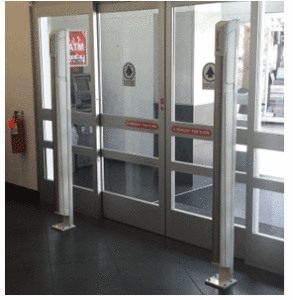A study done by the University of California at Berkley found that hiring a new employee costs an approximate $4,000 dollars per employee and in hiring for higher positions-professionals and management level employees-the figure increases to $7,000. If you are a small business, then the figure increases per every new employee you are trying to hire. If you are a small business that offers other benefits to their employees, the cost increases considerably. The importance of hiring quality employees, or training the employees you already have, are an economic advantage many businesses cannot pass. Hiring and training new employees is expensive, why not do it right the first time? Background checks, and recommendations from other employers are not something you can take lightly. Checked them before you hire, and it would likely paid dividends.
For more about this and other stories, follow the links below.
Loss Prevention Management Must Focus on Quality Recruitment and Retention
Loss prevention management has the power to improve understanding, morale, and workplace inclusion.
Let’s face it—the bottom line to any corporate organization is the profit margin. However, those in executive loss prevention management should always be mindful that quality of service drives the margin. Factors that lead to high-quality service are often the result of well-retained employees. Specifically, all management levels need to be mindful of what policies work, what don’t work, and what looks promising.
Recruitment and Training
Think back to when you first joined your company. What was your initial impression of the first few people you met when you went in for the initial interview? Do you remember their general attitude about the company?
Chances are that your initial impression was positive. Perhaps this is why you stayed. Do you think the same attitudes are being conveyed to new recruits today? If not, you might consider those colleagues who left the company. What was it about their experiences that differed from yours, that made them leave?
The Square Alliance met this morning to discuss ways to combat the increase in shoplifting in the hub of Oxford’s shopping. Business owners had a Q&A with OPD investigator Chris Case about how to prevent shoplifting and deal with those who are caught in the act.
Case provided tips in shoplifting prevention such as a more visible security system, keeping an eye out for suspicious activity and more. Business owners voiced their opinions and discussed certain tricks and trends that they’ve noticed shoplifters using to attempt to steal merchandise. Case mentioned that shoplifters will usually work in pairs rather than alone to attempt to distract workers while they commit the crime.
A heavy importance was placed on figuring out how to deal with shoplifters when they are caught in the act to find the balance of ensuring security but not overstepping the boundaries. Businesses and workers have the ability to recover stolen merchandise and keep the violator in the store until the authorities arrive, as long as they have probable cause. It is also unlawful to lock them in a small space such as a closet or use force.
 Wal-Mart has a unique way to cut down on shoplifting
Wal-Mart has a unique way to cut down on shoplifting
Wal-Mart has taken the law into its own hands.
No, the company has not started its own jail, and any employee who wears a cape and fights crime must still do so on his own time. Instead, the retail chain has taken a new approach to fighting shoplifting that requires less involvement from the police. The retailer has been using a “restorative justice” program in 1,500 of its stores, according to The Gainesville Sun. That’s a program in which people deemed low-risk, first-time offenders are given the choice of paying to take an anti-shoplifting course rather than facing arrest and prosecution.
The effort is in its early days, but the results have been good so far. The company has seen a 35% reduction in calls to law enforcement nationwide since restorative justice programs were first implemented, Wal-Mart spokesman Ragan Dickens told The Sun in an email.
“No retailer is immune to the challenge of crime. We recognize the importance of this issue at the highest levels of the company, and we are investing in people and technology to support our stores,” he wrote, noting that police are not being cut out of the loop.

 Daylight savings time is over and for most of us in the U.S. (yes, there are a few exceptions) we have moved our clocks and groaned at the loss of a precious hour of sleep. We have to adjust and get used to the change and eventually we do. For our personal lives there isn’t a lot of impact, once we are used to it we do benefit from the additional daylight and get to enjoy more outdoor activity. The time change is useful as a reminder for changing batteries in smoke detectors. You may even use it as a point when you will start planning your summer vacations. For business owners daylight savings time can be a reminder that it is time to conduct a store physical security review. Time changes may not impact us much individually but for retailers there is an impact for the building, employees and your customers.
Daylight savings time is over and for most of us in the U.S. (yes, there are a few exceptions) we have moved our clocks and groaned at the loss of a precious hour of sleep. We have to adjust and get used to the change and eventually we do. For our personal lives there isn’t a lot of impact, once we are used to it we do benefit from the additional daylight and get to enjoy more outdoor activity. The time change is useful as a reminder for changing batteries in smoke detectors. You may even use it as a point when you will start planning your summer vacations. For business owners daylight savings time can be a reminder that it is time to conduct a store physical security review. Time changes may not impact us much individually but for retailers there is an impact for the building, employees and your customers. When do closed circuit television malfunctions occur? I’m sure you can guess, it is always at the point when you need it most. I can’t recall the number of instances when I had a cash shortage I needed to look for and when I attempted to pull video through the DVR the video was already dropped or the camera wasn’t functioning. I remember having to look for an image of a suspect in a shoplifting incident and the picture was too grainy to be of any use due to a dirty camera lens or dome. One slightly embarrassing situation that stands out in my mind involved robberies that were taking place behind our store. I had developed a great working relationship with our local police department and they knew the quality of our camera system. Investigators came to me seeking assistance with outdoor camera footage to try to identify the criminals conducting the robberies. I pulled up video of the date and time in question and much to my chagrin the camera had a great shot of the ground directly underneath it. A power surge had impacted the programming of the pan/tilt/zoom (PTZ) camera and placed it in a default position. I had not noticed the problem in a timely fashion and could not recall how long it was before I did catch the issue. The good news was I was able to re-program the camera and eventually we did provide footage of an incident a little later that led to an arrest.
When do closed circuit television malfunctions occur? I’m sure you can guess, it is always at the point when you need it most. I can’t recall the number of instances when I had a cash shortage I needed to look for and when I attempted to pull video through the DVR the video was already dropped or the camera wasn’t functioning. I remember having to look for an image of a suspect in a shoplifting incident and the picture was too grainy to be of any use due to a dirty camera lens or dome. One slightly embarrassing situation that stands out in my mind involved robberies that were taking place behind our store. I had developed a great working relationship with our local police department and they knew the quality of our camera system. Investigators came to me seeking assistance with outdoor camera footage to try to identify the criminals conducting the robberies. I pulled up video of the date and time in question and much to my chagrin the camera had a great shot of the ground directly underneath it. A power surge had impacted the programming of the pan/tilt/zoom (PTZ) camera and placed it in a default position. I had not noticed the problem in a timely fashion and could not recall how long it was before I did catch the issue. The good news was I was able to re-program the camera and eventually we did provide footage of an incident a little later that led to an arrest. When I was a Loss Prevention Manager we would catch a shoplifter or a dishonest employee and recover merchandise. Depending on the type of case we would sometimes hold the evidence for a few days until the court hearing other times it could be much longer. If a shoplifter refused to plead guilty or requested a jury trial cases could be held up for months if not longer. I had several cases that went on for more than a year. Felony shoplifting cases and juvenile cases in our jurisdiction often meant lengthy wait periods depending on caseloads in the court. I also recall at least one shoplifting case in which the lawyer for the defendant requested extensions three separate times hoping that I would not appear for the hearing and the case would be dropped. No dice, I showed up for each hearing and finally the lawyer entered a guilty plea. The problem with the lengthy cases was that we would have to hold the evidence until the cases were settled. In some situations the police department held the recovered merchandise, such as when they stopped the suspect after the suspect fled the store. When merchandise has to be held for long periods it is possible for it to sit in evidence and be forgotten about. For stores that are too small to have security or Loss Prevention Departments management may be storing that evidence and no one is thinking about following up on cases with their police department or court.
When I was a Loss Prevention Manager we would catch a shoplifter or a dishonest employee and recover merchandise. Depending on the type of case we would sometimes hold the evidence for a few days until the court hearing other times it could be much longer. If a shoplifter refused to plead guilty or requested a jury trial cases could be held up for months if not longer. I had several cases that went on for more than a year. Felony shoplifting cases and juvenile cases in our jurisdiction often meant lengthy wait periods depending on caseloads in the court. I also recall at least one shoplifting case in which the lawyer for the defendant requested extensions three separate times hoping that I would not appear for the hearing and the case would be dropped. No dice, I showed up for each hearing and finally the lawyer entered a guilty plea. The problem with the lengthy cases was that we would have to hold the evidence until the cases were settled. In some situations the police department held the recovered merchandise, such as when they stopped the suspect after the suspect fled the store. When merchandise has to be held for long periods it is possible for it to sit in evidence and be forgotten about. For stores that are too small to have security or Loss Prevention Departments management may be storing that evidence and no one is thinking about following up on cases with their police department or court.
 The National Association for Shoplifting Prevention
The National Association for Shoplifting Prevention I recently read over an article opining the phrase “sales cures shrink”. While the author touched on both sides of the coin, I found it interesting that in today’s retail climate, anyone would think that you can simply sell your way out of losses. Let’s cut to the chase here; we’re not bringing in 20% increases over last year, hell we’re lucky to come in flat to last year. Online giants like Amazon are eating up market share like never before and if brick and mortar don’t do something fast, sales will continue to slump.
I recently read over an article opining the phrase “sales cures shrink”. While the author touched on both sides of the coin, I found it interesting that in today’s retail climate, anyone would think that you can simply sell your way out of losses. Let’s cut to the chase here; we’re not bringing in 20% increases over last year, hell we’re lucky to come in flat to last year. Online giants like Amazon are eating up market share like never before and if brick and mortar don’t do something fast, sales will continue to slump. I’ve been doing employee theft investigations for years now. Sometimes, they’re a blast. Often, they frustrate me. Not because the person is a thief, but because the loss could be so avoidable if managers would take the time and play offense. Sure, we can run reports and watch video, but all that’s doing is keeping us on the D-Line. You have to play hard and not be afraid to call an audible when needed.
I’ve been doing employee theft investigations for years now. Sometimes, they’re a blast. Often, they frustrate me. Not because the person is a thief, but because the loss could be so avoidable if managers would take the time and play offense. Sure, we can run reports and watch video, but all that’s doing is keeping us on the D-Line. You have to play hard and not be afraid to call an audible when needed.